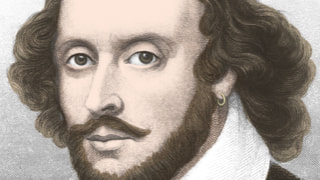Summary: Act II, scene ii
Within the castle, Claudius and Gertrude welcome Rosencrantz and Guildenstern, two of Hamlet’s friends from Wittenberg. Increasingly concerned about Hamlet’s erratic behavior and his apparent inability to recover from his father’s death, the king and queen have summoned his friends to Elsinore in the hope that they might be able to cheer Hamlet out of his melancholy, or at least discover the cause of it. Rosencrantz and Guildenstern agree to investigate, and the queen orders attendants to take them to her “too much changed” son (II.ii.36).
Polonius enters, announcing the return of the ambassadors whom Claudius sent to Norway. Voltimand and Cornelius enter and describe what took place with the aged and ailing king of Norway: the king rebuked Fortinbras for attempting to make war on Denmark, and Fortinbras swore he would never again attack the Danes. The Norwegian king, overjoyed, bequeathed upon Fortinbras a large annuity, and urged him to use the army he had assembled to attack the Poles instead of the Danes. He has therefore sent a request back to Claudius that Prince Fortinbras’s armies be allowed safe passage through Denmark on their way to attack the Poles. Relieved to have averted a war with Fortinbras’s army, Claudius declares that he will see to this business later. Voltimand and Cornelius leave.
Turning to the subject of Hamlet, Polonius declares, after a wordy preamble, that the prince is mad with love for Ophelia. He shows the king and queen letters and love poems Hamlet has given to Ophelia, and proposes a plan to test his theory. Hamlet often walks alone through the lobby of the castle, and, at such a time, they could hide behind an arras (a curtain or wall hanging) while Ophelia confronts Hamlet, allowing them to see for themselves whether Hamlet’s madness really emanates from his love for her. The king declares that they will try the plan. Gertrude notices that Hamlet is approaching, reading from a book as he walks, and Polonius says that he will speak to the prince. Gertrude and Claudius exit, leaving Polonius alone with Hamlet.
Polonius attempts to converse with Hamlet, who appears insane; he calls the old man a “fishmonger” and answers his questions irrationally. But many of Hamlet’s seemingly lunatic statements hide barbed observations about Polonius’s pomposity and his old age. Polonius comments that while Hamlet is clearly mad, his replies are often “pregnant” with meaning (II.ii.206). He hurries away, determined to arrange the meeting between Hamlet and Ophelia.
As Polonius leaves, Rosencrantz and Guildenstern enter, and Hamlet seems pleased to see them. They discuss Hamlet’s unhappiness about recent affairs in Denmark. Hamlet asks why they have come. Sheepishly, the two men claim they have come merely to visit Hamlet, but he sternly declares that he knows that the king and queen sent for them. They confess this to be true, and Hamlet says that he knows why: because he has lost all of his joy and descended into a state of melancholy in which everything (and everyone) appears sterile and worthless.
Rosencrantz smiles and says he wonders how Hamlet will receive a theatrical troupe that is currently traveling toward the castle. The trumpets blow, announcing the arrival of the actors (or “players”). Hamlet tells his friends they are welcome to stay at Elsinore, but that his “uncle-father and aunt-mother” are deceived in his madness. He is mad only some of the time and at other times is sane.
Polonius enters to announce the arrival of the players, who follow him into the room. Hamlet welcomes them and entreats one of them to give him a speech about the fall of Troy and the death of the Trojan king and queen, Priam and Hecuba. Impressed with the player’s speech, Hamlet orders Polonius to see them escorted to guestrooms. He announces that the next night they will hear
He immediately begins cursing himself, bitterly commenting that the player who gave the speech was able to summon a depth of feeling and expression for long-dead figures who mean nothing to him, while Hamlet is unable to take action even with his far more powerful motives. He resolves to devise a trap for Claudius, forcing the king to watch a play whose plot closely resembles the murder of Hamlet’s father; if the king is guilty, he thinks, he will surely show some visible sign of guilt when he sees his sin reenacted on stage. Then, Hamlet reasons, he will obtain definitive proof of Claudius’s guilt. “The play’s the thing,” he declares, “wherein I’ll catch the conscience of the king” (II.ii.581–582).
Read a translation of Act II, scene ii
Analysis
If Hamlet is merely pretending to be mad, as he suggests, he does almost too good a job of it. His portrayal is so convincing that many critics contend that his already fragile sanity shatters at the sight of his dead father’s ghost. However, the acute and cutting observations he makes while supposedly mad support the view that he is only pretending. Importantly, he declares, “I am but mad north-north-west: when the wind is southerly I know a hawk from a handsaw” (II.ii.361–362). That is, he is only “mad” at certain calculated times, and the rest of the time he knows what is what. But he is certainly confused and upset, and his confusion translates into an extraordinarily intense state of mind suggestive of madness.
Read more about madness as a theme.
This scene, by far the longest in the play, includes several important revelations and furthers the development of some of the play’s main themes. The scene contains four main parts: Polonius’s conversation with Claudius and Gertrude, which includes the discussion with the ambassadors; Hamlet’s conversation with Polonius, in which we see Hamlet consciously feigning madness for the first time; Hamlet’s reunion with Rosencrantz and Guildenstern; and the scene with the players, followed by Hamlet’s concluding soliloquy on the theme of action. These separate plot developments take place in the same location and occur in rapid succession, allowing the audience to compare and contrast their thematic elements.
We have already seen the developing contrast between Hamlet and Laertes. The section involving the Norwegian ambassadors develops another important contrast, this time between Hamlet and Fortinbras. Like Hamlet, Fortinbras is the grieving son of a dead king, a prince whose uncle inherited the throne in his place. But where Hamlet has sunk into despair, contemplation, and indecision, Fortinbras has devoted himself to the pursuit of revenge. This contrast will be explored much more thoroughly later in the play. Here, it is important mainly to note that Fortinbras’s uncle has forbidden him to attack Denmark but has given him permission to ride through Denmark on his way to attack Poland. This at least suggests the possibility that the King of Norway is trying to trick Claudius into allowing a hostile army into his country.
Read more about who Fortinbras is.
It is notable that Claudius appears indifferent to the fact that a powerful enemy will be riding through his country with a large army in tow. Claudius seems much more worried about Hamlet’s madness, indicating that where King Hamlet was a powerful warrior who sought to expand Denmark’s power abroad, Claudius is a politician who is more concerned about threats from within his state.
Read important quotes by Claudius.
The arrival of Rosencrantz and Guildenstern, two of the most enigmatic figures in
What a piece of work is man! How noble in reason! how infinite in faculties! in form and moving, how express and admirable! in action how like an angel! in apprehension, how like a god! the beauty of the world! the paragon of animals! And yet, to me, what is this quintessence of dust? (II.ii.293–298)
The other important event in this scene is the arrival of the players. The presence of players and play-acting within the play points to an important theme: that real life is in certain ways like play-acting. Hamlet professes to be amazed by the player king’s ability to engage emotionally with the story he is telling even though it is only an imaginative recreation. Hamlet is prevented from responding to his own situation because he doesn’t have certain knowledge about it, but the player king, and theater audiences in general, can respond feelingly even to things they know to be untrue. In fact, most of the time people respond to their real-life situations with feelings and actions that are not based on certain knowledge. This is what Hamlet refuses to do. His refusal to act like he knows what he’s doing when he really doesn’t may be construed as heroic and appropriate, or quixotic and impossible. In either case, Hamlet’s plan to trap the king by eliciting an emotional response is highly unsound: Claudius’s feelings about a play could never be construed as a reliable index of its truth.

Take the Act II, scene ii Quick Quiz

Read a translation of Act II, scene ii



 payment page
payment page



